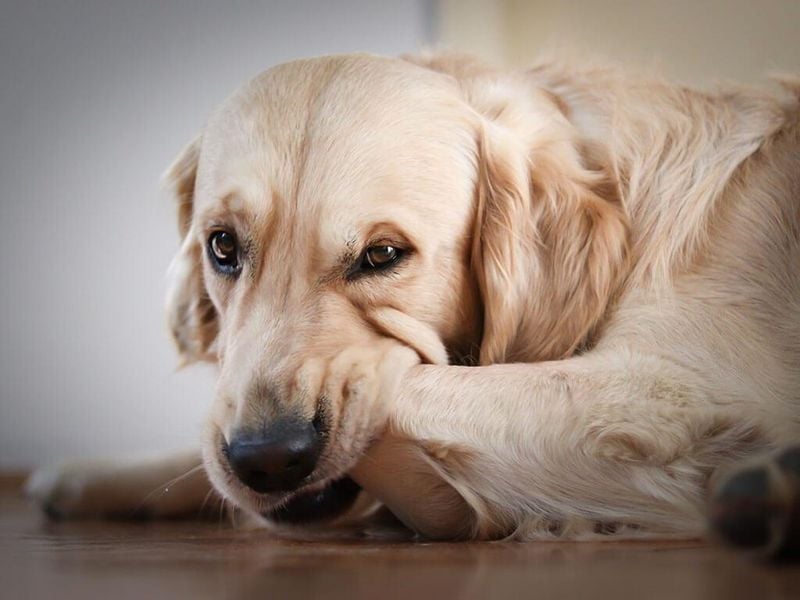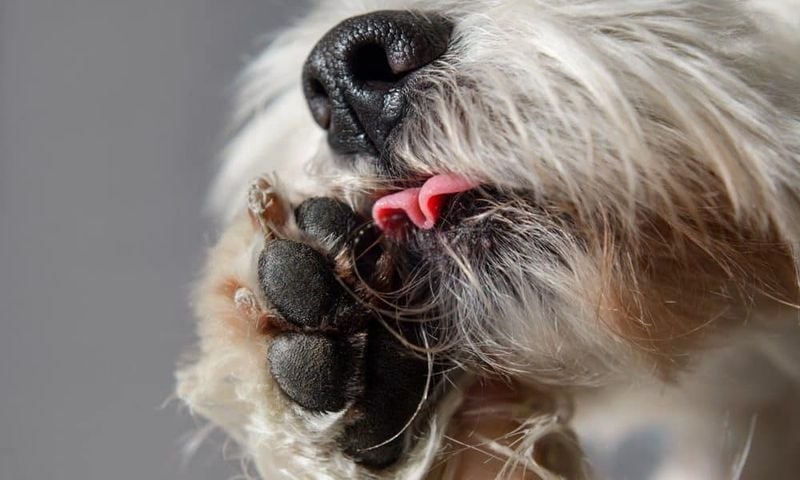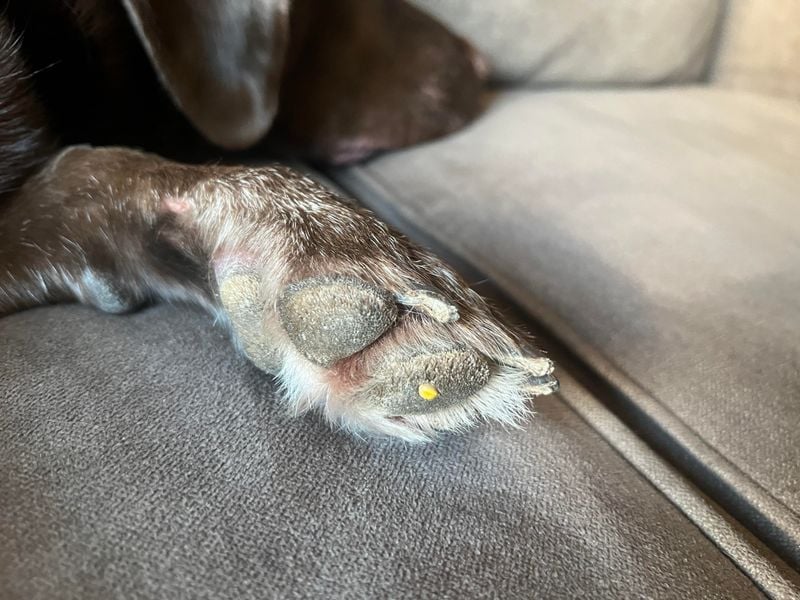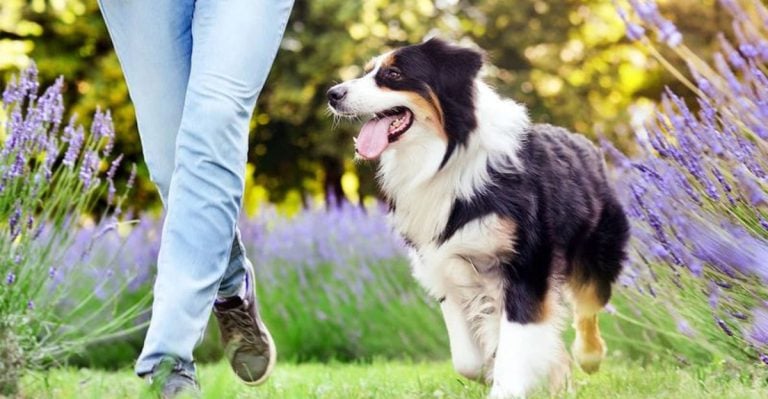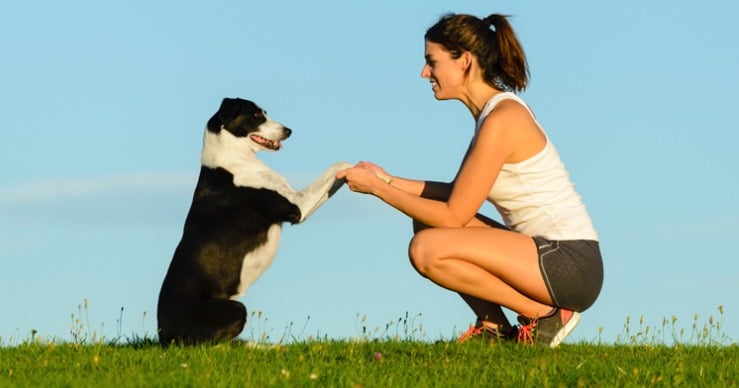What It Really Means When Dogs Chew Their Paws
You’re relaxing on the couch, and out of the corner of your eye, you notice your dog gnawing away at their paw like it’s a chew toy.
At first, it seems harmless—just a quick nibble, maybe a scratch. But then it happens again… and again… and again. Before you know it, it’s become a full-blown habit.
The licking, the chewing, the paw obsession—suddenly, you’re on Google at 2 a.m. typing, “Why does my dog chew their paws?”
You’re not alone—and yes, there is a reason (actually, several) behind this quirky, sometimes concerning behavior.
Some causes are relatively minor: dry skin, a piece of grass stuck between the toes, or itchy feet from a long day outdoors. Others are more complex, ranging from chronic allergies to behavioral disorders that need real attention.
Whatever the case, persistent paw-chewing isn’t something you want to ignore. The challenge is figuring out why it’s happening. Because unlike a sneeze or a limp, this isn’t a one-size-fits-all symptom.
It can be a clue to an underlying medical condition, emotional stress, or even something as simple as an overgrown nail. To help unravel the mystery, we asked a veterinary dermatologist to break it all down.
From the most common medical triggers to the lesser-known psychological ones, we’re digging into every possible reason. Plus, we’ll share tips on when to worry, when to step in, and what you can do to help your pup find relief.
1. Itching From Allergies: The Most Common Culprit
Environmental allergens like pollen, mold, or dust mites are frequent triggers, especially in seasonal cases. Dogs can be just as susceptible to allergens as humans, and their paws are often the first indicator.
You might notice your dog licking or chewing excessively, particularly during certain times of the year.
This behavior might seem cute, but it can lead to more serious skin problems if not addressed. A vet can help diagnose the specific allergens and recommend appropriate treatments, like antihistamines or special shampoos.
Addressing allergies not only helps with paw chewing but can improve overall quality of life for your furry friend. Being mindful of the environment and making minor adjustments can prevent these allergens from taking a toll on your dog.
2. Food Sensitivities That Manifest Through the Paws
Certain proteins or fillers in kibble can cause systemic inflammation, leading to paw chewing as a symptom.
Dogs experiencing food sensitivities may have other signs like gastrointestinal issues or itchy skin. It’s not uncommon for these symptoms to go unnoticed until paw chewing becomes excessive.
By conducting an elimination diet or allergy test, you can pinpoint the offending ingredients. Switching to a hypoallergenic or specially formulated diet can alleviate the issue and provide relief to your pet.
Monitoring your dog’s reaction to different foods is crucial in maintaining their health.
With a bit of detective work, you’ll be able to ensure your dog enjoys its meals without the added discomfort of itchy paws.
3. Parasites: Fleas, Mites, and Ticks
Even if you don’t see them, microscopic pests can burrow or bite, causing intense localized itching. Fleas, mites, and ticks are notorious for making a home in your dog’s fur and paws, leading to relentless scratching and chewing.
These pests can be found in various environments, from grassy fields to your backyard. Regular grooming and the use of preventive treatments can keep these pesky invaders at bay.
If your dog is already infested, a vet-prescribed treatment plan will be necessary to eradicate the parasites.
Keeping your dog’s living area clean and using repellents can prevent future infestations, ensuring your dog’s comfort and health.
4. Yeast or Bacterial Infections
Warm, moist paw pads are the perfect breeding ground for fungal or bacterial overgrowth, leading to redness, odor, and irritation. If your dog’s paws have a funky smell, it might be more than just a dirty issue.
These infections can cause significant discomfort and lead to constant chewing or licking. The good news is that they are often treatable with medicated shampoos or topical treatments prescribed by your vet.
Regular cleaning and drying of your dog’s paws can also prevent these infections from taking hold. Ensuring your dog has clean, dry paws after walks, especially in wet conditions, can go a long way in maintaining their paw health.
5. Dry, Cracked, or Irritated Skin
Winter salt, hot pavement, or dry air can chap paw pads, making them sore and chew-worthy.
Just like humans use lip balm in cold weather, dogs need protection for their paws. If your dog is licking its paws after a winter walk, it might be reacting to the salt or ice.
Moisturizing balms and booties can provide excellent protection against harsh elements. Regularly checking your dog’s paws for signs of dryness or damage is essential.
By keeping the paw pads hydrated and shielded from extreme conditions, you can prevent painful cracks and chewing habits.
6. Behavioral Issues: Anxiety, Stress, or Boredom
Just like nail-biting in humans, repetitive paw-chewing can be a soothing habit that masks deeper emotional needs. Dogs may chew their paws to cope with anxiety, stress, or simply because they’re bored.
Understanding your dog’s emotional state is key to addressing this behavior. Providing mental stimulation and physical exercise can help alleviate stress and boredom.
Behavioral training or consulting with a professional can also provide strategies to manage anxiety.
Creating a calm and engaging environment can turn paw-chewing into a thing of the past, enriching your dog’s life.
7. Obsessive-Compulsive Disorder (OCD) in Dogs
When chewing becomes frequent and intense—even when no irritant is present—it may be a compulsive behavior that requires intervention.
OCD in dogs is more common than you might think and can manifest in various ways, including repetitive paw-chewing.
This behavior can be distressing for both the dog and the owner. Consulting with a veterinarian can help identify if OCD is the cause and explore treatment options, such as behavioral therapy or medication.
By addressing the underlying compulsion, you can improve your dog’s quality of life and reduce the stress associated with compulsive behaviors.
8. Pain or Injury in the Paw
A thorn, cut, splinter, or even a broken toenail can lead a dog to lick or chew in an attempt to relieve discomfort. These injuries are often easy to spot, but some may require a closer look.
Regular inspections of your dog’s paws can help catch these issues before they become serious.
Keeping a first-aid kit handy with essentials like antiseptic wipes and bandages can aid in immediate care.
If the injury seems severe, consulting a vet is always the best course of action. Quick response to paw injuries can prevent long-term discomfort for your pet.
9. Foreign Objects or Debris Between Toes
Small pebbles, burrs, or grass awns can get stuck and lead to frantic chewing until the object is removed. Dogs that love exploring might encounter various debris that get lodged between their toes.
A quick inspection and removal of the foreign object can often solve the problem.
Regularly cleaning your dog’s paws after walks and playtime can prevent these situations. Using a gentle brush or comb can help dislodge debris and keep paws clean.
By maintaining a routine paw check, you can ensure your dog stays comfortable and free from irritation.
10. Poor Grooming or Overgrown Nails
Matted fur between paw pads or nails curling into the skin can lead to irritation and chewing behavior. Regular grooming isn’t just about looking good; it’s essential for your dog’s health. Overgrown nails can cause pain and even lead to infections.
By keeping a consistent grooming schedule, you can prevent these issues from arising. Trimming nails and keeping fur tidy around the paws will make a world of difference for your pet’s comfort.
Professional groomers can offer guidance if you’re unsure how to maintain your dog’s grooming routine at home.
11. Reactions to Topical Products or Floor Cleaners
Dogs can develop contact dermatitis from surfaces they walk on—like bleached floors or lawn treatments. You might notice redness or irritation on your dog’s paws after exposure to certain products.
Opting for pet-friendly cleaning solutions can help prevent these reactions. If you suspect a particular product is causing problems, a patch test can be useful in identifying the culprit.
Keeping your floors and yard dog-safe ensures your furry friend’s paws remain healthy and irritation-free. Simple changes in your cleaning routine can have a significant impact on your dog’s comfort.
12. Breed Predispositions to Skin Conditions
Certain breeds (e.g., Bulldogs, Labs, Golden Retrievers) are more prone to atopic dermatitis and paw-chewing behaviors. If your dog belongs to one of these breeds, being proactive in managing skin health is crucial.
Regular vet check-ups and monitoring for early signs of skin issues can help maintain their well-being. Understanding your dog’s specific needs based on their breed can guide you in providing the best care possible.
Awareness of breed-specific health concerns allows you to take preventive measures and ensure your pet enjoys a happy, itch-free life.
13. When to See a Veterinarian
Red flags that indicate something more serious is going on and professional help is necessary. If your dog’s paw chewing is accompanied by bleeding, swelling, or persistent limping, it’s time to consult a vet.
Delaying professional intervention can lead to more severe health problems. Veterinarians can conduct thorough exams to determine the root cause of the issue and recommend appropriate treatments.
Being attentive to your dog’s behavior and seeking timely veterinary care can prevent complications and promote healing. Ensuring your pet’s well-being is a top priority for every responsible dog owner.
14. How Vets Diagnose the Underlying Issue
From skin scrapings to allergy testing, a quick rundown of what a typical exam might include. Veterinarians have a variety of tools at their disposal to get to the bottom of paw-chewing issues.
They may perform a physical examination, take skin samples, or conduct blood tests to rule out infections.
Understanding the diagnostic process can help alleviate concerns and prepare you for what to expect during a visit.
Open communication with your vet and asking questions can provide peace of mind and ensure your dog receives the best care possible.
Collaboration with your vet leads to successful diagnosis and treatment, keeping your dog happy and healthy.
15. Treatment Options and Relief Remedies
Includes prescription meds, medicated wipes, natural balms, and behavioral therapies. Once the underlying cause of paw chewing is identified, treatment can begin.
Options range from medications to soothe allergies to behavioral therapies for stress relief.
Natural balms and medicated wipes offer convenient, non-invasive solutions for mild irritations.
Veterinarians can recommend the best course of action tailored to your dog’s needs. Adhering to a treatment plan ensures a smooth recovery and prevents recurring issues.
By exploring various remedies, you can find the most effective solution for your pet, ensuring their paws remain healthy and itch-free.
16. Preventative Tips to Keep Paws Healthy
Suggestions like regular grooming, paw washing after walks, seasonal booties, and parasite prevention. Taking proactive measures can save your dog from the discomfort of paw chewing.
Simple practices like washing your dog’s paws after outings or using protective booties in harsh weather make a difference. Regular grooming and keeping an eye out for potential irritants are essential for maintaining paw health.
Parasite prevention treatments keep fleas and ticks at bay, ensuring your dog enjoys life without the itch. Consistent care and attention to your dog’s paws will keep them looking and feeling their best.

